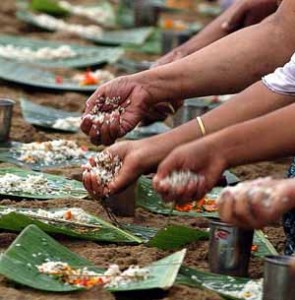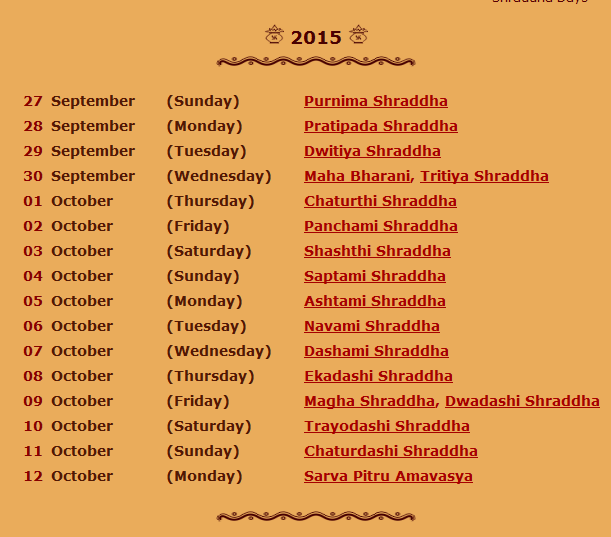In this article we will see both the reasons for celebrating pitru pakshas or shraddhs, from ancient perspective as well in context of its relevance and significance in modern day society. In the ancient texts, pitrus or pitras refer to ancestors and paksha means a particular time. So the term pitru paksha suggests it is the time when we offer prayers and food to the ancestors.
 Mythology Relating to King Karna
Mythology Relating to King Karna
Traditionally pitru paksha or shraddh is a custom that is followed by the Hindus on a regular basis. It is said that if you fail to offer water and food to the ancestors in the pitru paksha then in the afterlife you will also remain without food and water.
We all know of the king Karna from Mahabharata. He was the son of sun god. During his life he was considered to be very deeply involved in charity. He could not say no to anyone. When he died and went to heaven the gods would give him food made of gold. Karna asked the gods that he was such a famous king and would do so much charity then why was he given food made of gold. The king of the gods Indra told him that this was so as Karna in his life was only donating gold and gems.
He never offered food and water to the poor and neither to his ancestors. King Karna realised his mistake and he wanted to correct the same. The gods decided that Karna will be allowed to get back to earth for sixteen days and feed the poor and the needy. This would help him to get rid of the problem.
What is Pitru Paksha?
These sixteen days when king Karna was on Earth were called the pitru paksha. These days are considered very inauspicious and even today no new activity or a good task is done on these days. The Hindus offer prayers and food to the ancestors in this time. This ensures that the pitru dosha is done away with. It also ensures that the entire family is blessed. The pitru paksha is followed only by the male members of the family.
Pitru Paksha Dates 2015
The exact dates of the pitru paksha keep changing every year. In 2015 the pitru paksha starts from the 27th of September and ends on the 12th of October. The pitru paksha starts on a full moon day and ends on a no moon day also known as the poornima and amavasya respectively. The last day of the pitru paksha is the Mahalaya. We have an article that is dedicated to the Mahalaya and its significance.
Avoid New Activity During This Period
If you are planning to start any new activity then please avoid this period as it is not a good time. The manner and way in which pitru paksha rituals are performed differs from region to region.
On the shradh day many people keep fast for the ancestors to rest in peace. Many people do not cut their hair during the pitru paksha as it is considered a bad omen. Many people have different names for the pitru paksha. We are mentioning them so that you do not get confused to hear the other terms. These are
- tarpanam
- sola shradha
- shradham
Why Please Ancestors?
You may ask why you should please the ancestors or whether there is life after death? If they are dead then why should we bother about them? Well when your ancestors are not resting in peace you too will not be able to be in peace. You will often face some problem or the other. There will be disputes in the family. Women will not be able to bear children. The family members will be meeting with unforeseen accidents and the list will just go on.
When the ancestors are resting in peace you can see that your home and family will be prospering. Just because the ancestors are dead we should not forget them. They should be prayed to and offered food and water. If the deceased do not have a son then the immediate family members can also do the shradha puja. This puja also cleans the sinful deeds of the deceased soul and ensures that they rest in peace.
The person who is performing the shradha puja during the pitru paksha must do it with complete dedication and with whole heart. You could also do it under guidance of a learned priest.
You must keep handy the list of your ancestors who have left for their heavenly abode. Try to keep the names of at least the previous seven generations. The puja must be offered to both the men as well as the women. After the puja food must be offered to the ancestors. We will deal in more details with the shradha puja done in pitru paksha in our next article.
Significance In Modern Day Concept
We always try to present all information and knowledge with relevance to changing society and the modern age as well. For those who have faith, the above should be more than enough reason to follow pitru paksha but for others there are reasons too, some of them being outlined as follows:
1. The society is becoming extremely materialistic and things like giving something to someone without a reasons, like food and clothing are getting scarce. Hence the celebration of pitru paksha should act to somehow awaken these habits in people.
2. Even if you do not think that the people who have left for their heavenly abode do not need anything, still the actual things you are offering are to the poor and the needy so in a way you are helping them out
3. It is always good to remain connected with the past and the ancestors and not completely forget them. This time at least acts as a special fortnight where you can do so and try and learn something about your ancestors and possibly draw a leaf from the book of their lives.
4. Apart from the ancestors who have departed, this also symbolizes taking care of the elders which is very important in modern day society where the aged people are not getting proper care and get isolated
So we do urge that you celebrate pitru paksha for at least one of the reasons mentioned above. We hope that by reading this article you will be able to understand better what pitru paksha is. Do try to follow the important points that we have mentioned in this article.
This will help you to get more peace and happiness for yourself and your family. Now that you know the importance of these days then do ensure that you do the puja this year and seek blessings of your ancestors. You will see the impact in your life over time for sure.
